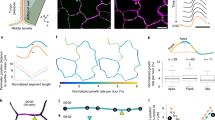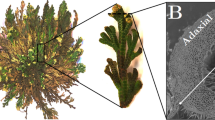Abstract
To survive, plants constantly adapt their body shape to their environment. This often involves remarkably rapid bending of their organs such as stems, leaves and roots. Since plant cells are enclosed by stiff cell walls, they use various strategies for bending their organs, which differ from bending mechanisms of soft animal tissues and involve larger physical forces. Here we attempt to summarize and link different viewpoints on bending mechanisms: genes and signalling, mathematical modelling and biomechanics. We argue that quantifying cell growth and physical forces could open a new level in our understanding of bending and resolve some of its paradoxes.
This is a preview of subscription content, access via your institution
Access options
Access Nature and 54 other Nature Portfolio journals
Get Nature+, our best-value online-access subscription
$29.99 / 30 days
cancel any time
Subscribe to this journal
Receive 12 digital issues and online access to articles
$119.00 per year
only $9.92 per issue
Buy this article
- Purchase on Springer Link
- Instant access to full article PDF
Prices may be subject to local taxes which are calculated during checkout




Similar content being viewed by others
References
Yamamoto, C., Sakata, Y., Taji, T., Baba, T. & Tanaka, S. Unique ethylene-regulated touch responses of Arabidopsis thaliana roots to physical hardness. J. Plant Res. 121, 509–519 (2008).
Rafsanjani, A., Brulé, V., Western, T. L. & Pasini, D. Hydro-responsive curling of the resurrection plant Selaginella lepidophylla. Sci. Rep. 5, 8064 (2015).
Dietrich, D. Hydrotropism: how roots search for water. J. Exp. Bot. 69, 2759–2771 (2018).
La Porta, C. A. M. et al. Metamaterial architecture from a self-shaping carnivorous plant. Proc. Natl Acad. Sci. USA 116, 18777–18782 (2019).
Philosoph-Hadas, S., Friedman, H. & Meir, S. Gravitropic bending and plant hormones. Vitam. Horm. 72, 31–78 (2005).
Whippo, C. W. & Hangarter, R. P. Phototropism: bending towards enlightenment. Plant Cell 18, 1110–1119 (2006).
Kiss, J. Z. Up, down, and all around: how plants sense and respond to environmental stimuli. Proc. Natl Acad. Sci. USA 103, 829–830 (2006).
Silk, W. K. Quantitative descriptions of development. Annu. Rev. Plant Physiol. 35, 479–518 (1984).
Rauf, M. et al. NAC transcription factor SPEEDY HYPONASTIC GROWTH regulates flooding-induced leaf movement in Arabidopsis. Plant Cell 25, 4941–4955 (2013).
Baral, A. et al. External mechanical cues reveal a katanin-independent mechanism behind auxin-mediated tissue bending in plants. Dev. Cell 56, 67–80.e3 (2021).
Peng, Y. et al. Growth asymmetry precedes differential auxin response during apical hook initiation in Arabidopsis. J. Integr. Plant Biol. 64, 5–22 (2022).
Liscum, E. & Hangarter, R. P. Light-stimulated apical hook opening in wild-type Arabidopsis thaliana seedlings. Plant Physiol. 101, 567–572 (1993).
Silk, W. K. & Erickson, R. O. Kinematics of hypocotyl curvature. Am. J. Bot. 65, 310–319 (1978).
Spalding, E. P. Diverting the downhill flow of auxin to steer growth during tropisms. Am. J. Bot. 100, 203–214 (2013).
Barbez, E., Dünser, K., Gaidora, A., Lendl, T. & Busch, W. Auxin steers root cell expansion via apoplastic pH regulation in Arabidopsis thaliana. Proc. Natl Acad. Sci. USA 114, E4884–E4893 (2017).
Fu, X. & Harberd, N. P. Auxin promotes Arabidopsis root growth by modulating gibberellin response. Nature 421, 740–743 (2003).
Zádníková, P. et al. Role of PIN-mediated auxin efflux in apical hook development of Arabidopsis thaliana. Development 137, 607–617 (2010).
Barbosa, I. C. R., Zourelidou, M., Willige, B. C., Weller, B. & Schwechheimer, C. D6 PROTEIN KINASE activates auxin transport-dependent growth and PIN-FORMED phosphorylation at the plasma membrane. Dev. Cell 29, 674–685 (2014).
Stepanova, A. N. et al. TAA1-mediated auxin biosynthesis is essential for hormone crosstalk and plant development. Cell 133, 177–191 (2008).
Zhu, Q. et al. Root gravity response module guides differential growth determining both root bending and apical hook formation in Arabidopsis. Development 146, dev175919 (2019).
Mazzella, M. A., Casal, J. J., Muschietti, J. P. & Fox, A. R. Hormonal networks involved in apical hook development in darkness and their response to light. Front. Plant Sci. 5, 52 (2014).
Aryal, B. et al. Interplay between cell wall and auxin mediates the control of differential cell elongation during apical hook development. Curr. Biol. 30, 1733–1739.e3 (2020).
Jonsson, K. et al. Mechanochemical feedback mediates tissue bending required for seedling emergence. Curr. Biol. 31, 1154–1164.e3 (2021).
Zhang, Y. et al. Molecular insights into the complex mechanics of plant epidermal cell walls. Science 372, 706–711 (2021).
Braybrook, S. A. & Peaucelle, A. Mechano-chemical aspects of organ formation in Arabidopsis thaliana: the relationship between auxin and pectin. PLOS ONE 8, e57813 (2013).
Feraru, E. et al. PIN polarity maintenance by the cell wall in Arabidopsis. Curr. Biol. 21, 338–343 (2011).
Bastien, R., Bohr, T., Moulia, B. & Douady, S. Unifying model of shoot gravitropism reveals proprioception as a central feature of posture control in plants. Proc. Natl Acad. Sci. USA 110, 755–760 (2013).
Chelakkot, R. & Mahadevan, L. On the growth and form of shoots. J. R. Soc. Interface 14, 20170001 (2017).
Chauvet, H., Moulia, B., Legué, V., Forterre, Y. & Pouliquen, O. Revealing the hierarchy of processes and time-scales that control the tropic response of shoots to gravi-stimulations. J. Exp. Bot. 70, 1955–1967 (2019).
Meroz, Y., Bastien, R. & Mahadevan, L. Spatio-temporal integration in plant tropisms. J. R. Soc. Interface 16, 20190038 (2019).
Agostinelli, D., Lucantonio, A., Noselli, G. & DeSimone, A. Nutations in growing plant shoots: the role of elastic deformations due to gravity loading. J. Mech. Phys. Solids 136, 103702 (2020).
Bastien, R. & Meroz, Y. The kinematics of plant nutation reveals a simple relation between curvature and the orientation of differential growth. PLoS Comput. Biol. 12, e1005238 (2016).
Levernier, N., Pouliquen, O. & Forterre, Y. An integrative model of plant gravitropism linking statoliths position and auxin transport. Front. Plant Sci. 12, 474 (2021).
Martin, A. C. & Goldstein, B. Apical constriction: themes and variations on a cellular mechanism driving morphogenesis. Development 141, 1987–1998 (2014).
Hay, J. O., Moulia, B., Lane, B., Freeling, M. & Silk, W. K. Biomechanical analysis of the Rolled (RLD) leaf phenotype of maize. Am. J. Bot. 87, 625–633 (2000).
Meroz, Y. & Silk, W. K. By hook or by crook: how and why do compound leaves stay curved during development? J. Exp. Bot. 71, 6189–6192 (2020).
Bowling, A. J. & Vaughn, K. C. Gelatinous fibers are widespread in coiling tendrils and twining vines. Am. J. Bot. 96, 719–727 (2009).
Pütz, N. in Plant Roots (eds Waisel, Y, Eshel, A, Beeckman, T & Kafkafi, U.) Ch. 54 (CRC Press, 2002).
Gerbode, S. J., Puzey, J. R., McCormick, A. G. & Mahadevan, L. How the cucumber tendril coils and overwinds. Science 337, 1087–1091 (2012).
Hofhuis, H. et al. Morphomechanical innovation drives explosive seed dispersal. Cell 166, 222–233 (2016).
Rivière, M., Corre, Y., Peaucelle, A., Derr, J. & Douady, S. The hook shape of growing leaves results from an active regulatory process. J. Exp. Bot. 71, 6408–6417 (2020).
Hamant, O. et al. Developmental patterning by mechanical signals in Arabidopsis. Science 322, 1650–1655 (2008).
Hejnowicz, Z., Rusin, A. & Rusin, T. Tensile tissue stress affects the orientation of cortical microtubules in the epidermis of sunflower hypocotyl. J. Plant Growth Regul. 19, 31–44 (2000).
Baskin, T. I. & Jensen, O. E. On the role of stress anisotropy in the growth of stems. J. Exp. Bot. 64, 4697–4707 (2013).
Moulton, D. E., Oliveri, H. & Goriely, A. Multiscale integration of environmental stimuli in plant tropism produces complex behaviors. Proc. Natl Acad. Sci. USA 117, 32226–32237 (2020).
Fourcaud, T., Blaise, F., Lac, P., Castéra, P. & de Reffye, P. Numerical modelling of shape regulation and growth stresses in trees. Trees 17, 31–39 (2003).
Alméras, T., Thibaut, A. & Gril, J. Effect of circumferential heterogeneity of wood maturation strain, modulus of elasticity and radial growth on the regulation of stem orientation in trees. Trees 19, 457–467 (2005).
Gril, J., Jullien, D., Bardet, S. & Yamamoto, H. Tree growth stress and related problems. J. Wood Sci. 63, 411–432 (2017).
Kennaway, R., Coen, E., Green, A. & Bangham, A. Generation of diverse biological forms through combinatorial interactions between tissue polarity and growth. PLoS Comput. Biol. 7, e1002071 (2011).
Rebocho, A. B., Southam, P., Kennaway, J. R., Bangham, J. A. & Coen, E. Generation of shape complexity through tissue conflict resolution. eLife 6, e20156 (2017).
Hématy, K. et al. A receptor-like kinase mediates the response of Arabidopsis cells to the inhibition of cellulose synthesis. Curr. Biol. 17, 922–931 (2007).
Feng, W. et al. The FERONIA receptor kinase maintains cell-wall integrity during salt stress through Ca2+ signaling. Curr. Biol. 28, 666–675.e5 (2018).
Shih, H.-W., Miller, N. D., Dai, C., Spalding, E. P. & Monshausen, G. B. The receptor-like kinase FERONIA is required for mechanical signal transduction in Arabidopsis seedlings. Curr. Biol. 24, 1887–1892 (2014).
Ishikawa, H. & Evans, M. L. The role of the distal elongation zone in the response of maize roots to auxin and gravity. Plant Physiol. 102, 1203–1210 (1993).
Zhang, N. & Hasenstein, K. H. Distribution of expansins in graviresponding maize roots. Plant Cell Physiol. 41, 1305–1312 (2000).
Fendrych, M., Leung, J. & Friml, J. TIR1/AFB-Aux/IAA auxin perception mediates rapid cell wall acidification and growth of Arabidopsis hypocotyls. eLife 5, e19048 (2016).
Ikushima, T., Soga, K., Hoson, T. & Shimmen, T. Role of xyloglucan in gravitropic bending of azuki bean epicotyl. Physiol. Plant. 132, 552–565 (2008).
Velasquez, S. M. et al. Xyloglucan remodeling defines auxin-dependent differential tissue expansion in plants. Int. J. Mol. Sci. 22, 9222 (2021).
Acknowledgements
We apologize to those whose work is not cited due to space limitations. This research was supported by an International Post-doc grant from Vetenskapsrådet (2020-06442) to K.J., a Marie Curie Individual Fellowship grant to Y.M., grants from FRQNT (2021-NC-284190) and NSERC (RGPIN-2018-05762) to A.-L.R.-K., and grants from the Kempe Foundation and Vetenskapsrådet (2016-00504) to R.P.B.
Author information
Authors and Affiliations
Contributions
K.J., Y.M., A.-L.R.-K. and R.P.B. wrote the manuscript. K.J. and A.-L.R.-K. generated the figures.
Corresponding authors
Ethics declarations
Competing interests
The authors declare no competing interests.
Peer review
Peer review information
Nature Plants thanks Ali Ferjani, Arun Sampathkumar and the other, anonymous, reviewer(s) for their contribution to the peer review of this work.
Additional information
Publisher’s note Springer Nature remains neutral with regard to jurisdictional claims in published maps and institutional affiliations.
Rights and permissions
Springer Nature or its licensor (e.g. a society or other partner) holds exclusive rights to this article under a publishing agreement with the author(s) or other rightsholder(s); author self-archiving of the accepted manuscript version of this article is solely governed by the terms of such publishing agreement and applicable law.
About this article
Cite this article
Jonsson, K., Ma, Y., Routier-Kierzkowska, AL. et al. Multiple mechanisms behind plant bending. Nat. Plants 9, 13–21 (2023). https://doi.org/10.1038/s41477-022-01310-y
Received:
Accepted:
Published:
Issue Date:
DOI: https://doi.org/10.1038/s41477-022-01310-y
This article is cited by
-
The uneven molecular distribution: a connection with plant functioning and stress resilience
Phytochemistry Reviews (2024)



